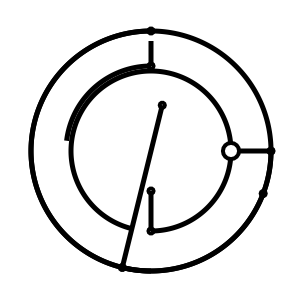A blog post from the old blog.ijaceebo.com, but a prime candidate to turn into an actual article once I finish moving these posts across.
The future is digital, after all.
I’ve been playing around for a little while with making some simple little web applications to play with digital sorcery1. I had them up on the old server2, but now that I’ve migrated I had to fight with the code a little bit to get it to work nicely. I don’t really remember what I did the first time, so it was a real learning experience this time3.
Currently online are a few python apps that I wrote. One generates a random “alchemy circle” in the style of Full Metal Alchemist4. The other two are just automated sigil creation tools. They both take an intent as a query string and sigilize it, using either a traditional kamea/“Magic Square” or a “Witches Circle” pattern. They’re not ideal, exactly5, but I still really like how they come out looking6.
But now that these are up… what do I do? I’ve had an idea for a while that I wanted to be able to put the sigils into the circles, but I’m not sure if that would look good or even is that feasible without completely rewriting the code for all 3 applications. For right now, I guess I’ll just be comfortable with them as they are, and maybe look into changing them as I go along and remind myself how to develop for web.
I’ve also got an idea cooking up for extracting some deep data analysis from blogging7. Like, if I can tag these posts with emotions, or even magickal intent, and then be able to run them through something to extract meaning and associations from them. But that’s a BIG PROJECT™ that will take a bit of work and research, and is far more complex than just getting a Python or NodeJS app to run on the server. That’s much more of a full web application. Let’s face it: after a full day at the office developing web apps, sometimes I just want to relax and not worry about it8.

This is a branch of occultism that I will refer to as “techgnosis” because it sounds cool. The idea is to balk the tradition of keeping technology/science and magick separate (though whether that’s a real tradition or just a useful fictional device is left for the reader to interpret) and to fuse the two into a new tool. Smartphones become the new scrying mirror, Google becomes the new servitor/familiar, iPads become the new grimoires.↩︎
This is now referring to the server 2 full iterations before this project. Thank you, Digital Ocean, for making it easy to reinstall a clean image every time.↩︎
I no longer remember what I did the first time or this last time↩︎
I don’t know about you, but I always thought that their “magick designs looked far better than most of the grimoires show, and I personally really like the look and feel of that sort of”high fantasy” magick circle. This is probably also why I enjoyed the look of the magick in the Dr. Strange movies… It looked on screen the way it looks in my mind. In the end, isn’t that all you really need in order for magick to work in the first place? As long as you feel like it works, and the entire working feels adequately “magickal” that you can believe it works… Just think of it like the Machine Spirit is helping.↩︎
The “Witches Circle” one in particular doesn’t like to draw lines over itself. I think it has to do with the fuzzy math being used to draw the arcs from letter to letter, but I still like the labyrinthine results it produces.↩︎
Actually, this is one of the projects I’ve liked enough to revisit lately. I’ve started porting the code over to Google Colab for easier development, but plan on moving it back to this server once I have some nice looking results. I could also always just bite the bullet and install a local Jupyter notebook.↩︎
This new site is actually a much better source for something like this. The text is written in markdown, so it’s easy to parse, and Pandoc should be able to give me the raw textual content. I can also tag the articles with more semantically verbose tags, and the template framework should let me display the results easier and in a more meaningful way.↩︎
If only past me knew how much time we’d be spending lately running ML models on Google Colab, maybe he wouldn’t have thought of it so poorly. As I’ve been porting these articles, I’ve been considering how easy it would be to run sentiment analysis on them. That could be an interesting metric: track the mood of the post and correlate it to anything else I want. And if I continue to tag some of the more mental-health related posts with my perceived mood, it could be a fascinating dark mirror to hold up against “how I see myself”↩︎